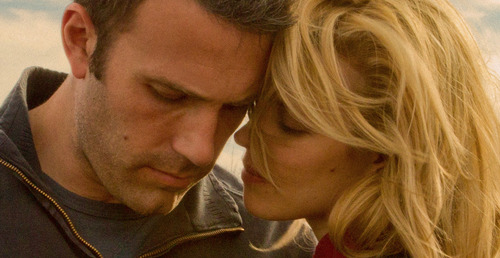 “To the Wonder,” the marvelous new film by writer/director Terrence Malick, marks a departure for the famously reclusive filmmaker in that it comes just two years after his last film, “The Tree of Life.”
“To the Wonder,” the marvelous new film by writer/director Terrence Malick, marks a departure for the famously reclusive filmmaker in that it comes just two years after his last film, “The Tree of Life.”
By Noah Gittell
 “To the Wonder,” the marvelous new film by writer/director Terrence Malick, marks a departure for the famously reclusive filmmaker in that it comes just two years after his last film, “The Tree of Life.” Malick has been known to go two decades between features, so the quick production and release of this film would seem to signify some sort of shift in his work, and the film bears that out. On the surface, Malick is exploring the same territory he has before, but in a new, contemporary setting that makes it feel like his most vital work in years.
“To the Wonder,” the marvelous new film by writer/director Terrence Malick, marks a departure for the famously reclusive filmmaker in that it comes just two years after his last film, “The Tree of Life.” Malick has been known to go two decades between features, so the quick production and release of this film would seem to signify some sort of shift in his work, and the film bears that out. On the surface, Malick is exploring the same territory he has before, but in a new, contemporary setting that makes it feel like his most vital work in years.
The themes of his films are written in stone. There is the perfect triangle of love, faith, and nature — points of transcendence that his characters often reach for but never fully grasp. There is always an innocent, child-like narrator to guide us through the interplay of these elements. In “Badlands,” it was Sissy Spacek’s naïve American teenager, and in “The Thin Red Line,” it was Jim Caviezel’s runaway World War II soldier. In their struggles to meld the ethereal with the corporeal, his characters often encounter wrath – the swarm of locusts and subsequent fire in “Days of Heaven” or the terror of a violent father in “The Tree of Life” — but Malick consistently finds salvation in moments of physical grace on which his camera lingers. Indeed, it appears that this is his artistic purpose – to find the Heaven amidst this Hell.
In “Wonder,” he explores the impact of suburban American culture on his perfect triangle. As the film opens, Neil (Ben Affleck), an American businessman, has fallen in love with Marina (Olga Kurylenko), a young, beautiful Parisian, on his trip to Europe. The opening scenes bring Neil and Marina to Mont St. Michel, where their love takes on ancient proportions under the spell of the island’s history and natural beauty. Enchanted by the moment, Neil invites Marina and her daughter to live with him in Oklahoma, and we are suddenly transported to the here and now, where contemporary American culture plays the role of the oppressor previously occupied by war, colonialism, and abusive fathers.
Like many Europeans, she and her daughter are at first seduced by America — they are amazed at the endless rows of canned goods at a supermarket. Her acceptance of suburban culture, however, is not to be taken too seriously; Marina is without roots and behaves like a child playing hooky. She runs through the wheat fields and licks the rain off a tree branch. Still, it is not long before the culture that at first fascinates her reveals its dark underbelly, and each point on Malick’s perfect triangle is threatened.
Neil, an environmental engineer, seems stressed by a vague development at work; it involves some kind of pollutant in the water supply. He brings his stress home, where Marina is failing to live up to his American notions of domesticity…. Eventually and without a clear reason (“Something is missing,” her daughter whispers to her at one point), he allows Marina and her daughter to return to Paris without him, and he strikes up another relationship with an old flame (Rachel McAdams) who has recently been widowed.
Meanwhile, we meet a South American priest (Javier Bardem), whose faith is being tested by the crushing poverty of his flock. Like Marina, he is a foreigner whose innocence is in danger of being swallowed by America’s failures, in this case the struggling economy and its impact on the poor. There may be a political point to be made here, but Malick is only concerned with the bigger questions.
Although it sounds typically opaque, “To the Wonder “is more of a straightforward narrative than we expect of Malick. There is very little dialogue and the voice-over narration includes recycled lines from earlier films (“What is this love that loves us?”) that offer little insight, yet the director somehow manages to make us understand what his characters are thinking, and the moments of catharsis – including a reveal that one character has had an affair and the other’s visceral reaction – feel at once vivid and inevitable.
As these lonely people seek transcendence from their material existences – whether by climbing the steps of an ancient monastery or a cheap and dirty Oklahoma motel – their struggles to self-actualize resonate. Malick may not have changed his style, but he has slowly and surely brought it closer to home, and the results are breathtaking.
My Rating: See it in the Theater















